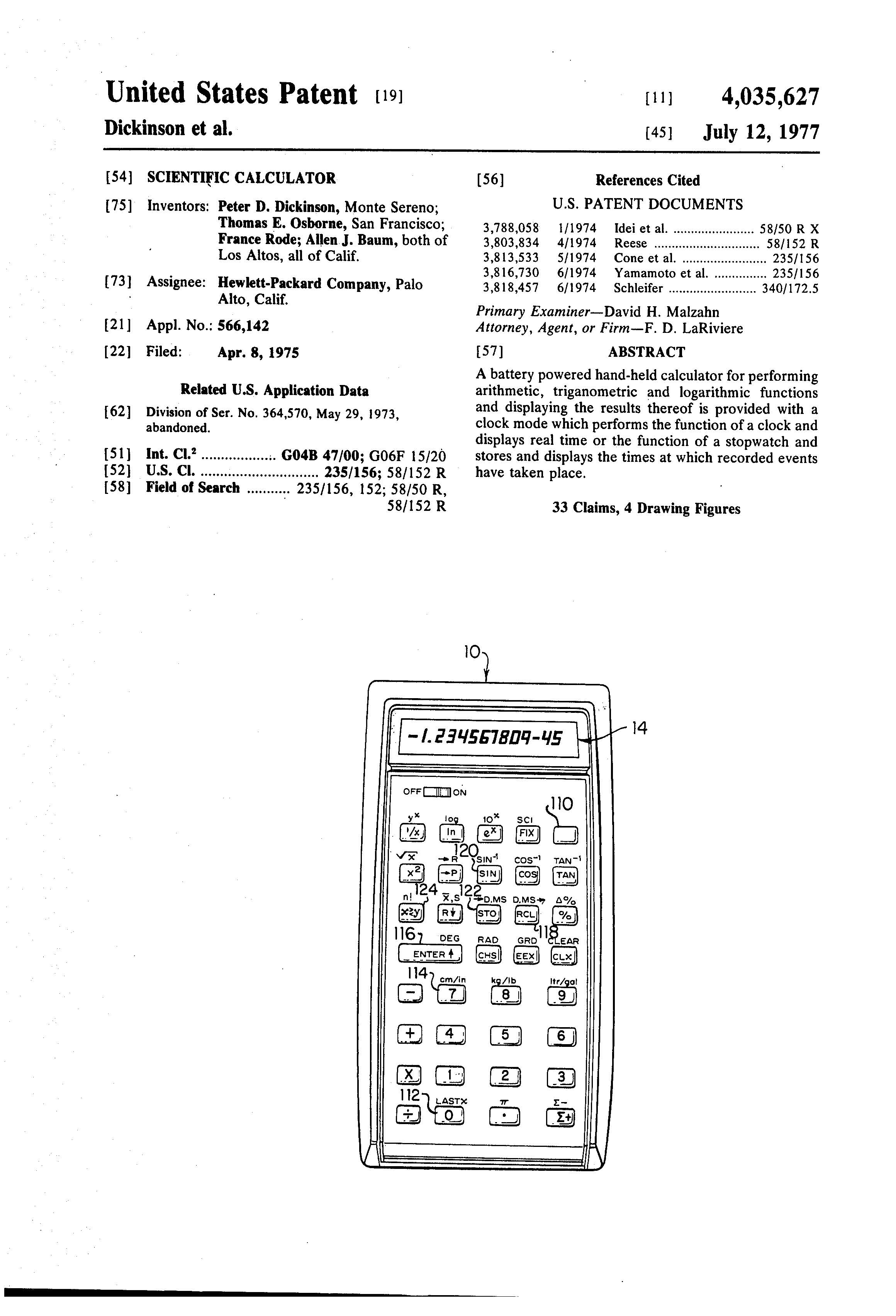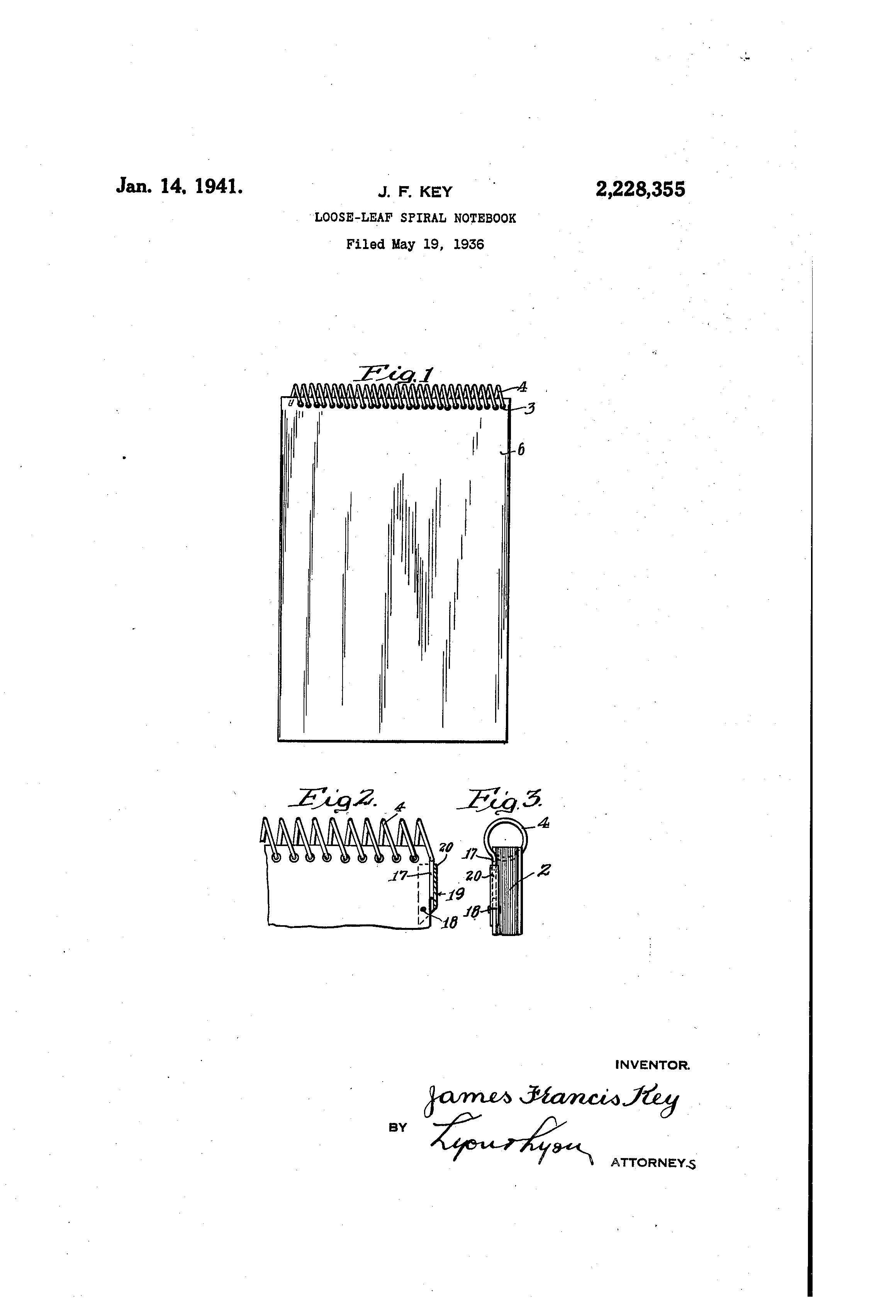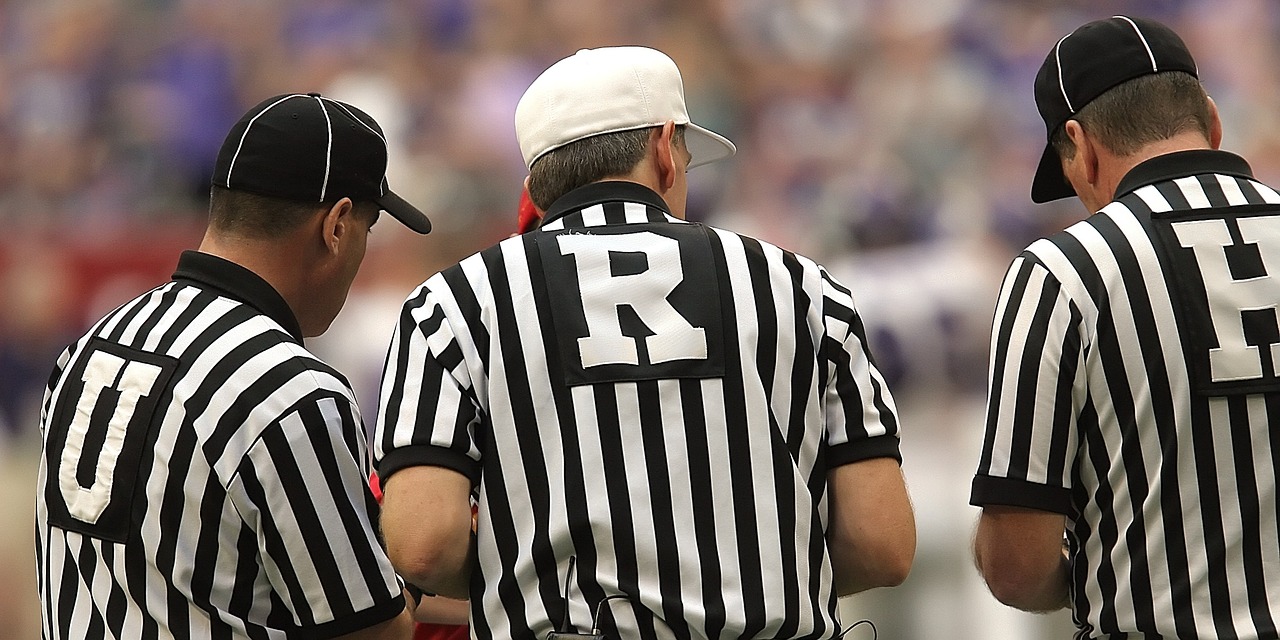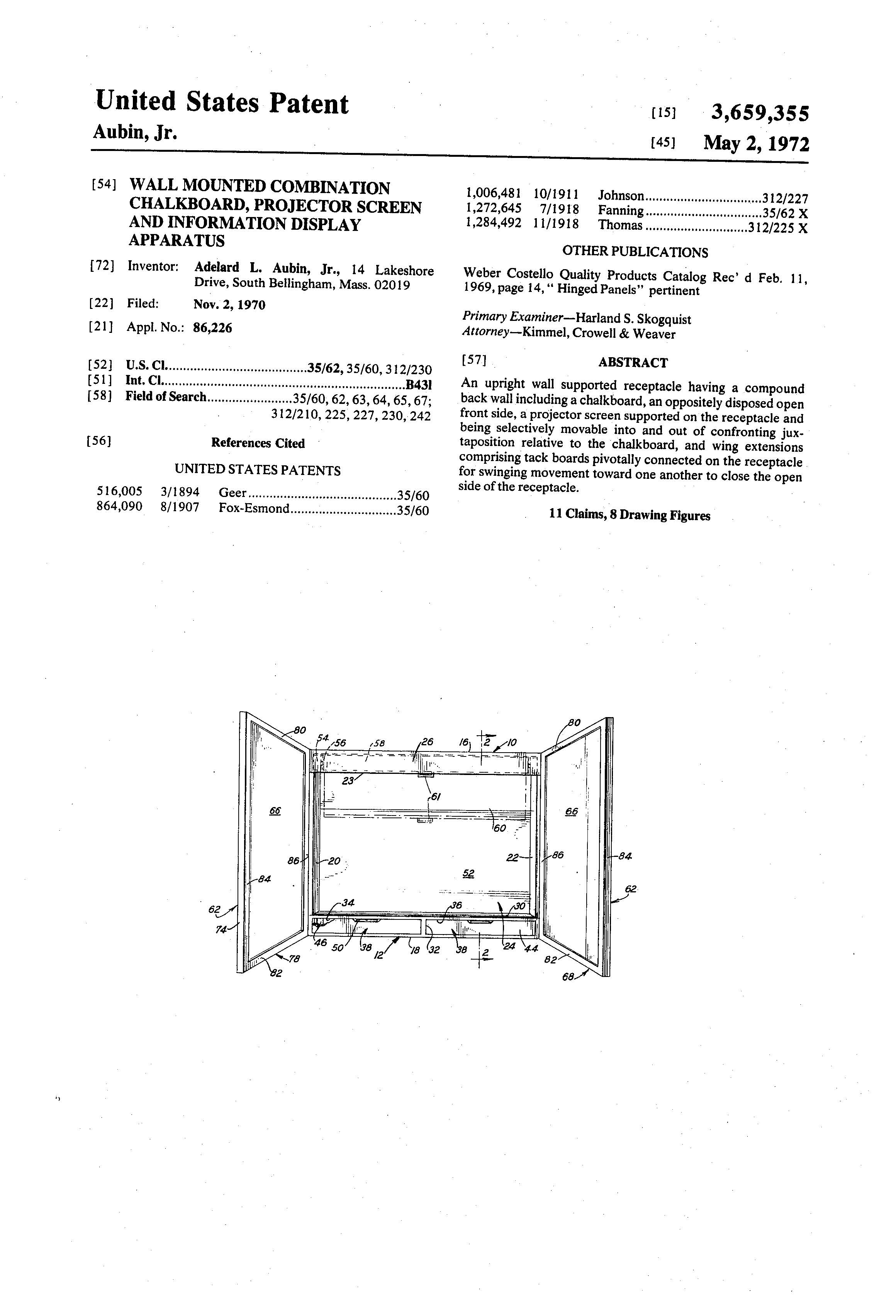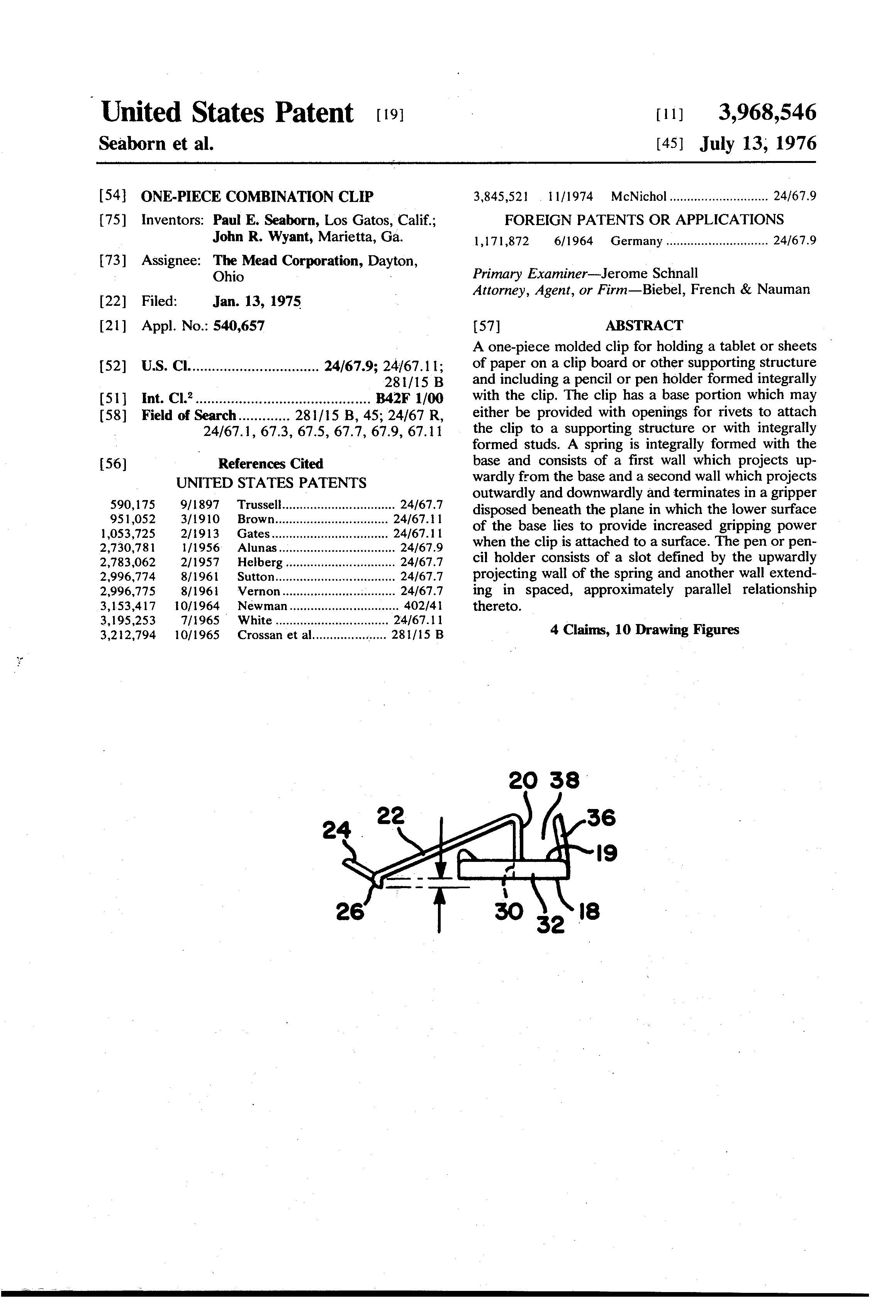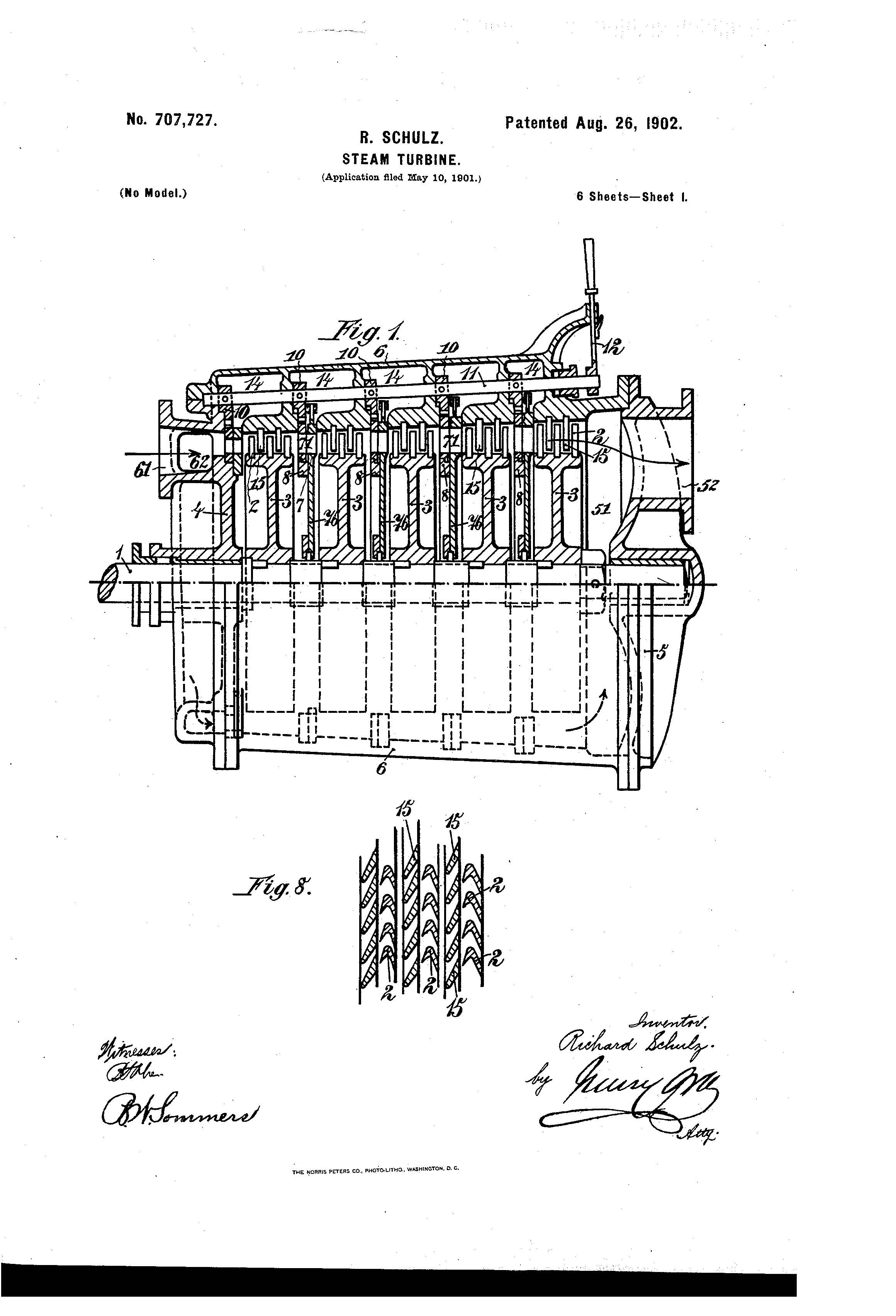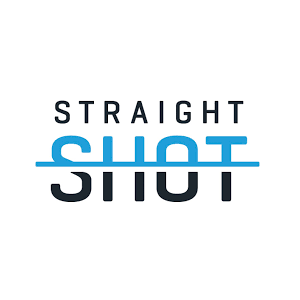Back to School Patent of the Day: Scientific Calculator
Assignee Hewlett-Packard Company and Inventors Peter Dickinson, Thomas E. Osborne, France Rode and Allen H. Baum were granted the patent for Scientific Calculator on July 12, 1977. U.S. Patent No. 4,035,627.
A battery powered hand-held calculator for performing arithmetic, triganometric and logarithmic functions and displaying the results thereof is provided with a clock mode with performs the function of a clock and displays real time or the function of a stopwatch and stores and displays the times at which recorded events have taken place.

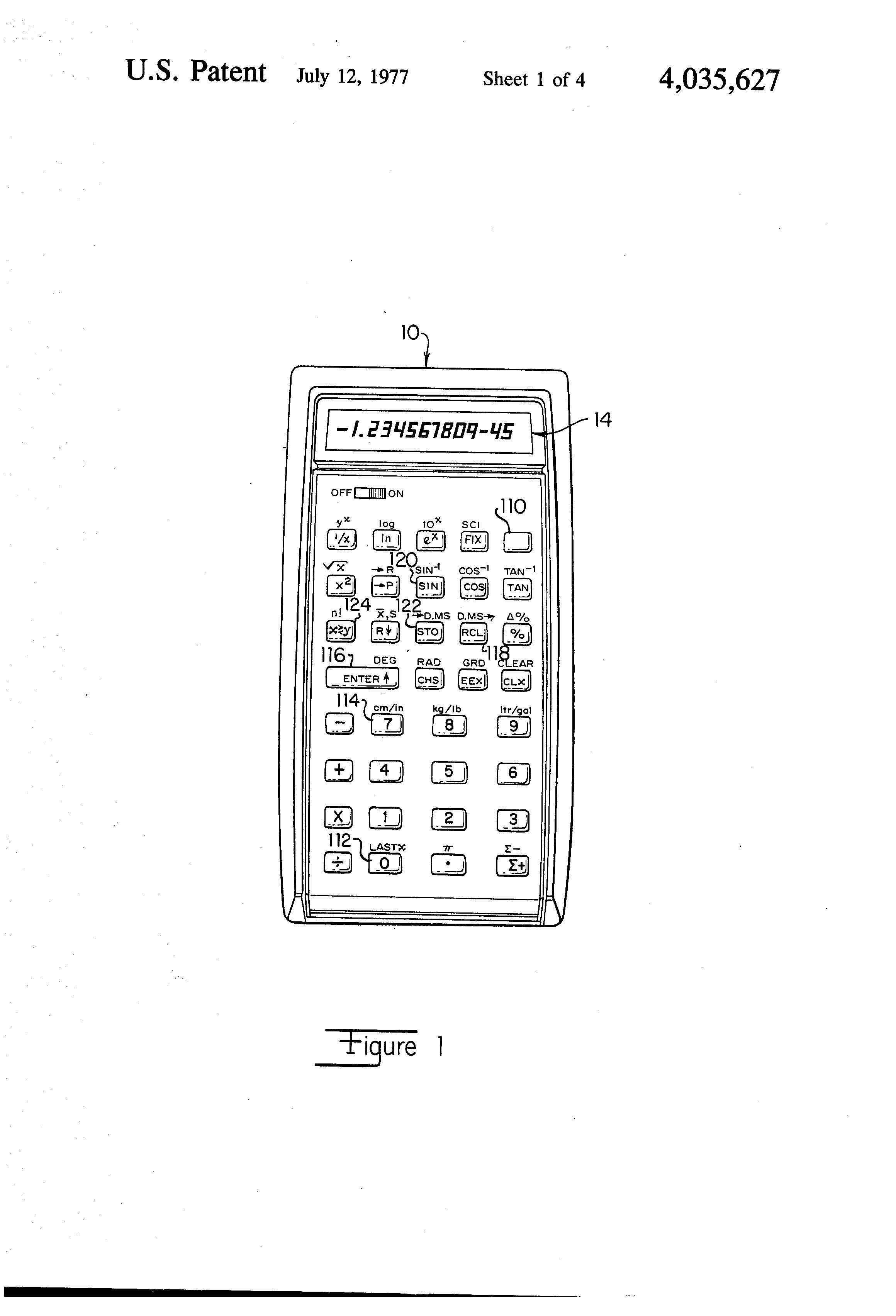



Educational Material Meets Intellectual Property

There are several different ways students utilize their senses to acquire and retain information, often referred to as learning styles or learning modalities. Four learning styles educators commonly employ are auditory, visual, tactile and kinesthetic. Most students learn well using all four modalities, but have one or more way in which they learn best. Presenting the material in a variety of ways is an effective tool to reach all students. Because of this, many programs and educational materials have been created over the years to aid students in the learning process.
For many teachers of the 1970s, 1980s, and early 1990s, the animated songs of School House Rock® (Trademark Registration No 1293368) became a way for teachers to reach students across all learning styles. Schoolhouse Rock was created by David McCall, part owner of the New York City based advertising agency McCaffery & McCall. McCall noticed his son was having difficulty memorizing his multiplication tables but had no problems remembering the lyrics to popular rock songs. McCall brought in jazz musician Bob Dorough to create a medium that would incorporate music as a learning tool. The first song Dorough came up with was “Three is a Magic Number” and things grew from there. David McCall and his team took their storyboard to Michael Eisner, ABC’s Vice President for Children’s Programming, and Eisner bought the cartoon on the spot.
The first episode of Schoolhouse Rock premiered January 6, 1973, as a three-minute short played between cartoons. The series was originally called “Scholastic Rock” but that was altered when the publishing company Scholastic Inc. hired a lawyer demanding the name be changed. The show has been so successful that many governmental and lobbyist groups have their staffers watch “I’m Just a Bill” as part of their training. “Telegraph Line” is used to introduce first-year medical students to the nervous system at the University of Michigan Medical School as well as Columbia College of Physicians and Surgeons.
Sesame Street® (Trademark Registration Nos. 1025725 and 0974205) is another show that allows students to learn through different avenues. Lloyd Morrisett, Vice President, at the time, of the Carnegie Corporation, noticed how much time his young daughter was spending in front of the television and he wanted to find a way to stimulate learning while providing entertainment. He reached out to Joan Cooley, a public-television producer, and from there the two created Sesame Street, the longest running American children’s series.
Sesame Street premiered on November 9, 1969, and was described by CBS news writer Norman Morris as a “[concept] that will literally channel children’s avid interest in television into preparation for the educational journey so vital to their lives,” the show’s goal was to encourage “intellectual and cultural growth” and to teach children specific academic skills. The show uses images, songs, like the popular “One of These Things (Is Not Like the Other)”, short films, humor and the infamous cast of Muppets to convey an educational message to its viewers.
At home, many parents struggle with assisting their children with various learning issues. One father, saddened to see his son struggle with reading, became determined to find a way to make reading less stressful and more fun. That determination led to the creation of Hooked on Phonics® (Trademark Registration No. 1876555) which launched in 1987. The program uses systematic phonics and support stories to teach letter-sound correlations. The program soon became a household name and had a memorable tagline “Hooked on Phonics worked for me” as well as the trademarked phone number 1-800-ABCDEFG® (Trademark Registration No. 1877587).
According to the Hooked on Phonics website, “over three million families and thousands of schools have turned to our award-winning products to help their children and students reach their full potential.” The Hooked on Phonics brand has branched out to over 30 countries and has educational tools in areas such as math, handwriting and foreign language. Hooked on Phonics also created a comprehensive learning approach, Hooked on School Success® (Trademark Registration No. 2629995) covering all areas of school from test taking strategies to study habits. To accommodate on-the-go lifestyles, the company created apps for iOS and Android mobile devices.
With all these learning tools, people who live on “Sesame Street” can get “Hooked on Phonics” and make the “School House Rock.”
Back to School Patent of the Day: Loose-Leaf Spiral Notebook
James Francis Key was granted the patent for Loose-Leaf Spiral Notebook on January 14, 1941. U.S. Patent No. 2,228,355.
The primary purpose of this invention is to provide a loose-leaf notebook held together by a spiral or coil of wire, including suitable means by which the coil of wire may be held stationary in the normal use of the book but which permit the ready removal of the coil for replacement of the leaves of the book.

GO TEAM: Can I Use My Favorite Team’s Trademark?

College football season is here and games will be a mainstay on televisions across the country. Here in Nebraska, many of us bleed Husker red. While just east across the river, there are many diehard Hawkeye and Cyclone fans. When starting a new business, many of these loyal fans cannot imagine a better way to show their team spirit than to use a similar mark to their favorite team’s mascot, colors, or logo. Is it ok to use the Husker “N”, the Hawkeye logo, or any team’s logo for your own personal business? Unfortunately, the short answer is no.
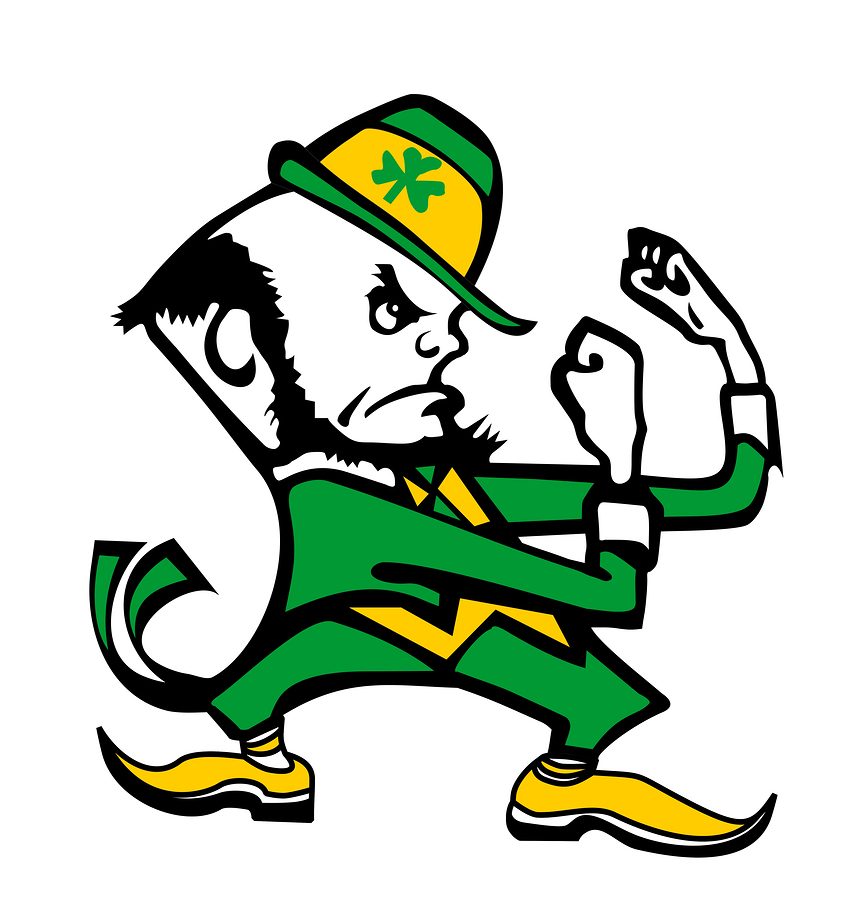 In the past few years, there has been a rush from colleges and universities to trademark their logos, mascots, colors, nicknames, slogans, and even in some cases, popular sayings and cheers. Some of the most recognized college trademarks include the Nebraska “N” (Registration No. 2,081,720), Notre Dame’s Leprechaun mascot (Registration No. 1,229,591), and the University of Iowa’s Hawkeye emblem (Registration No. 1,312,703). In fact, some universities have gone so far as to register more unusual trademarks. For instance, Boise State University has a trademark registration for the arrangement of the blue turf in their stadium (Registration No. 3,707,623) and the University of Arkansas has a registration for the sound of one of their popular cheers, “Calling the Hogs” (Registration No. 4,558,864).
In the past few years, there has been a rush from colleges and universities to trademark their logos, mascots, colors, nicknames, slogans, and even in some cases, popular sayings and cheers. Some of the most recognized college trademarks include the Nebraska “N” (Registration No. 2,081,720), Notre Dame’s Leprechaun mascot (Registration No. 1,229,591), and the University of Iowa’s Hawkeye emblem (Registration No. 1,312,703). In fact, some universities have gone so far as to register more unusual trademarks. For instance, Boise State University has a trademark registration for the arrangement of the blue turf in their stadium (Registration No. 3,707,623) and the University of Arkansas has a registration for the sound of one of their popular cheers, “Calling the Hogs” (Registration No. 4,558,864).
With colleges and universities (“school”) going to such great lengths to acquire trademark registrations, it is safe to assume they will enforce and protect those registrations. When it is brought to a school’s attention that a party is unjustly using one of their protected marks, the alleged infringer is usually sent a cease and desist letter from the school. This cease and desist letter will ask the infringer to immediately stop using the aforementioned mark or further legal action will be taken.
A letter could also arrive from the Collegiate Licensing Company. The Collegiate Licensing Company (“CLC”) is the trademark licensing representative for many universities, colleges, athletic conferences, the NCAA, and bowl games. In fact, the CLC manages licensing for over 200 universities and assists them in the management and protection of their marks. Among other things, the CLC is also responsible for determining which types of licenses are available, which product categories are available for licensing, which distribution channels may be licensed, and they also approve every product and design. This company goes to great lengths to protect the trademarks and branding of its clients. The Buna Cougars, a high school in Buna, Texas learned this the hard way when they received a cease and desist letter from the CLC who manages Penn State University's Nittany Lion trademarked logo. A sports vendor assured the school that their cougar logo was substantially different from that of the Nittany Lion's. Unfortunately, for the cougars that was not the case and the CLC demanded the school remove the logo from all their uniforms, paint over surfaces with the logo and stop using the logo for any other printed material or clothing.
If someone is really set on using a team’s trademark, licensing may be obtained. If done through the CLC, licensing is a three-phase process according to the company’s website. In additions to the three-phase process, licensing fees must be paid, and each school generally has a royalty rate. Schools that do not work with the CLC will have their own policies and procedures for licensing trademarks.
In the end, if you are planning on using a mark similar to a team’s logo or mascot in your business name or branding, you may be infringing on the trademarks of your team. At that point, you may be forced to call an audible (change your mark and marketing materials) which can be disruptive and costly.
Back to School Patent of the Day: Wall Mounted Combination Chalkboard, Projector Screen and Information Display Apparatus
On May 2, 1972, Adelard L. Aubin, Jr., was granted the patent for Wall Mounted Combination Chalkboard, Projector Screen and Information Display Apparatus. U.S. Patent No. 3,659,355.
An upright wall supported receptacle having a compound back wall including a chalkboard, an oppositely disposed open front side, a projector screen supported on the receptacle and being selectively movable into and out of confronting juxtaposition relative to the chalkboard, and wing extensions comprising tack boards pivotally connected on the receptacle for swinging movement toward one another to close the open side of the receptacle.



Back to School Patent of the Day: Talking Backpack
Dianne Sims was granted the patent for Talking Backpack on April 27, 1999. U.S. Patent No. 5,897,042.
A combination backpack and audio cassette system wherein the audio cassette system, separately contained, is mounted to the back panel of the backpack. The contained audio cassette system is provided with a simulated face, where the components thereof are accessible through various features of the simulated face, such as the mouth, nose, and ear.
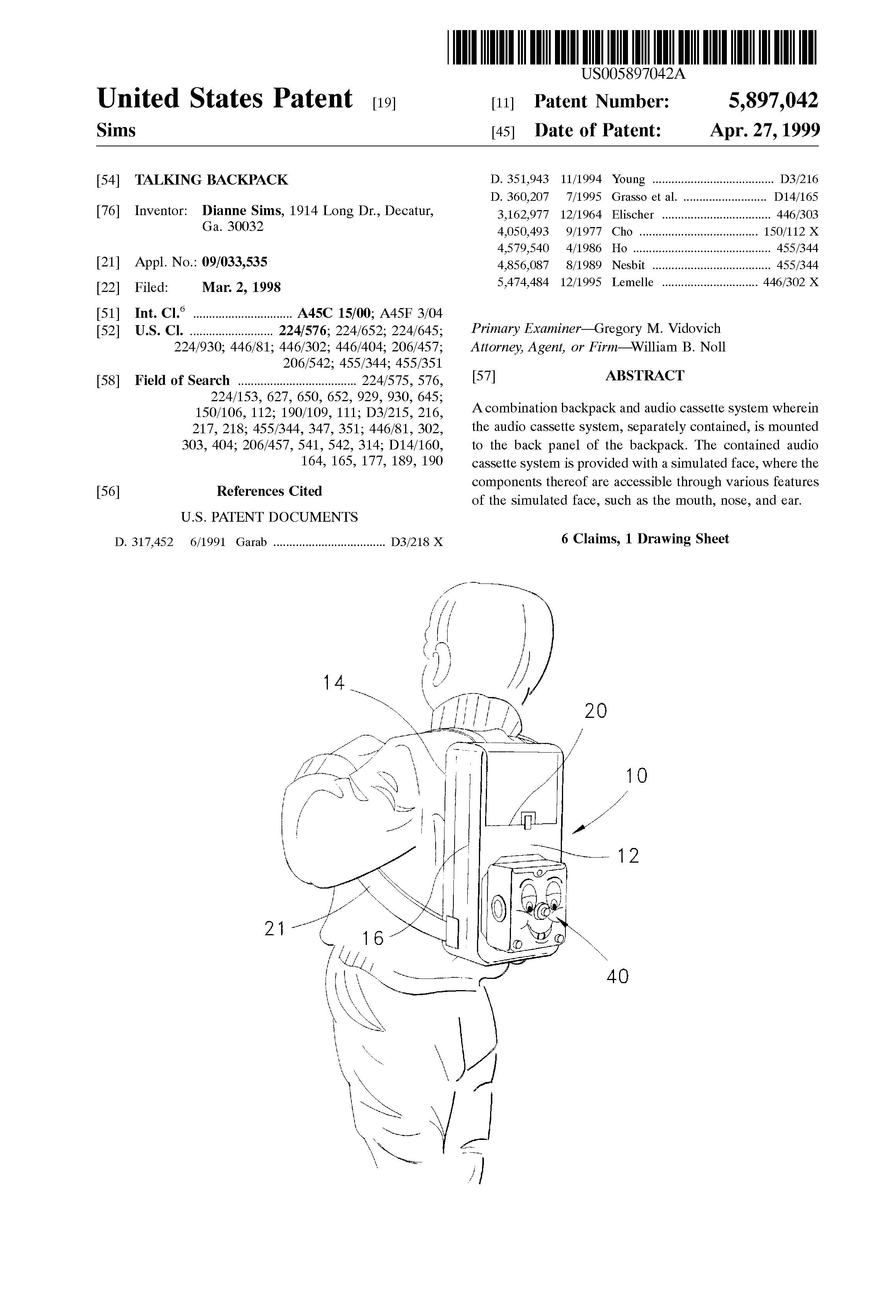
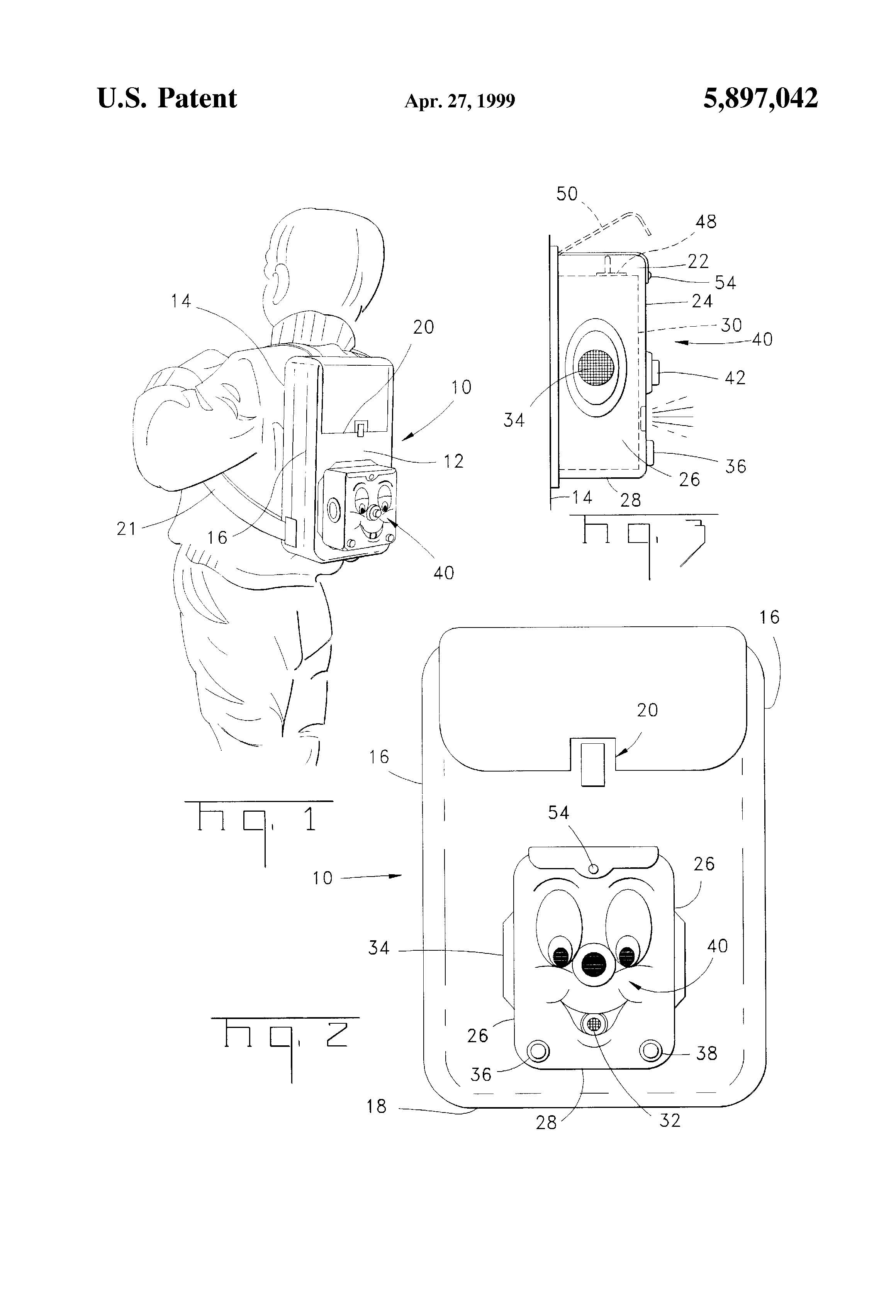
The Evolution of the School Bus

“The wheels on the bus go round and round”, so goes the British folk song and no doubt with school back in session, it is being sung today in many classrooms. Approximately half of the K-12 students in the United States are transported to and from school each day in school buses. The modern school bus has a long history that dates to the late nineteenth century. Children in rural America attended one-room schools, many students lived too far from the school to walk, so transportation was provided for them. The first vehicles for transporting students were called “kid hacks”. The word, “hack”, referred to a particular type of horse drawn carriages. Usually the kid hacks were modified farm wagons often utilizing benches for seats. The door was in the back to prevent startling the horses when boarding and dropping off students. In 1909, the Parry Manufacturing Company received a patent for improvements to a SCHOOL WAGON (U.S. Patent No. 937,953). One of the improvements provided for in this patent enabled a driver to open and close the rear doors from the driver seat to “prevent accidental injury to playful and mischievous passengers”.
With the introduction of motorized vehicles, kid hacks became motorized as well. The wagons were mounted to truck frames. Frequently, the wagon, or parts of the wagon, were removable so the vehicle, when not being used for student transportation, could transport other things. One example of a patent pertaining to one such convertible vehicle is DETACHABLE TOP AND SEAT FOR SCHOOL WAGONS granted to Fred W. Kruger on March 3, 1922 (U.S. Patent No. 1,409,555).
In the 1930s, a major shift began in the school bus design and configuration. The design transitioned from modified wagons and trucks to singular-purposed vehicles for transporting students. For safety reasons, the entry door was moved to the front and the rear door became an emergency exit. In 1927, A. L. Luce (a Ford dealership owner and future founder of Blue Bird Body Company) produced a wagon body made with steel panels and a wooden frame. Manufacturers such as Wayne Works, took this a step further. They began making all-steel automotive-type designs; they discontinued the wagon-style box. In 1930, Wayne Works produced the first vehicle with an all-steel body permanently mounted on a truck chassis. This combined vehicle became known as a school bus. J. K. Farris was granted a patent for SCHOOL BUS (U.S. Patent No. 2,112,150) on March 22, 1938.
By 1939, it was apparent to Dr. Frank W. Cyr, a rural education expert at Columbia University, standards for school buses were needed to improve design consistency, to reduce the complexity of school bus production and to increase safety. Dr. Cyr organized a conference and invited transportation officials, representatives from body and chassis manufacturers and paint companies. At the conclusion of the conference, 44 standards had been adopted, including a standard paint color known as “school bus yellow”. The color, which has been officially named National School Bus Glossy Yellow, was adopted because it is the easiest to see in the early morning light and at dusk and contrasts well with black lettering.
Improvements and modifications to the school bus abounded through the years largely by the efforts of the U.S. National Highway Traffic Safety Administration and bus industry and safety advocates. More recent modifications include: Improvement in SCHOOL BUS DOOR OPERATOR (U.S. Patent No. 6,264,267); STOP-ARM WITH CAMERA SYSTEM (U.S. Patent No. 9,321,401), and SCHOOL BUS TRACKING AND NOTIFICATION SYSTEM (US 20070024440).
There have been many modifications to the original 44 standards, but one standard remains in tack—the adoption of the color, school bus yellow; it is the shade most associated with school buses in the U.S. and around the world.
Back-to-School Intellectual Property

It is that time of year again-back to school time. Whether your student is excited or dreadful of this time of year, one thing is for certain, school supplies are a necessity.
A standard item, guaranteed to appear on almost all back to school lists, is the pencil. While the pencil has been around for a long time, one of the first-used pencils required a loaf of bread to erase the graphite material. In an attempt to improve upon the bread-eraser technique, Hymen Lipman developed a new pencil design and was granted the patent for it on March 30, 1868 (U.S. Patent No. 19,783). It was believed, at the time, that Lipman’s pencil was the first wood-cased pencil with an attached rubber eraser. The patent for this pencil was later purchased by Joseph Reckendorfer. Unfortunately, for Mr. Reckendorfer, the Supreme Court revoked this patent in 1875 after the German company Faber-Castell proved they created the first pencil equipped with a rubber eraser attached by a metal ferrule (i.e., a ring or cap). Since Lipman simply combined a pencil and an eraser and did not create/invent either of those items the patent was invalidated.
Another item seen on many back to school lists is Crayola® crayons. Crayola, originally Binney & Smith, was started by founders Edwin Binney and Harold Smith. Binney and Smith started out producing carbon black from natural gas. In 1891, Binney was granted a patent for an “Apparatus for the Manufacture of Carbon Black” that allowed for the mass production of carbon black (U.S. Patent No. 453,140). This invention enabled the company to become one of the largest manufacturers of pigment. They began to manufacture slate pencils and entered into the school industry with the creation of their An-Du-Septic Dustless Chalk and the Staonal Marking Crayon made with carbon black and oilfield paraffin. Teachers loved the crayons but had a hard time letting the children use them, as they were not safe for excessive use. Binney and Smith eventually got the formula right, and in 1903, the first box of eight Crayola crayons was born. It contained red, orange, yellow, green, blue, violet, brown, and black sticks and sold for a nickel. Edwin Binney’s wife Alice is credited with naming the brand, “craie,” the French word for chalk, and “ola,” from “oléagineux,” which means oily. Since the creation of the crayon, Crayola has gone on to make countless school-related items, including colored pencils, markers and Silly Putty to name a few.
With all the back to school items a student needs, having a place to keep everything is also essential. In 1976, the Mead Corporation gifted the world with Trapper Keeper Notebooks (U.S. Patent No. 3,968,546). The well-known Trapper Keeper Notebook was not released to the public until 1978. In doing so, Mead Corporation created “one of the most recognized school brands of all time,” says Jessica Hodges, Director of School Marketing for ACCO Brands, who acquired Mead in 2012. It is also a prominent pop culture hallmark: Trapper Keepers have been featured on Family Guy, Dawson’s Creek, South Park, Full House, and Napoleon Dynamite.” The Grammy winning artist John Mayer has also commented on Trapper Keepers referring to them as “the genesis of OCD for my generation.”
In addition to back to school supplies, it is always wise to think about cold and flu season and how easily germs can spread in a classroom. Classrooms around the country are stocked with the well-known facial tissue brand, Kleenex ®. The Kleenex brand has been around since 1914, but their origin predates their production of facial tissues, which made their brand a household name. The Kimberly-Clark Corporation originally used their cellucotton material for gas mask filters and dressing for wounds during World War I. When the war ended, Kimberly-Clark needed a new market for the cellucotton, and in 1924, the Kleenex name was trademarked (Registration No. 0191941) and launched. The facial tissue was originally used to remove cold creams and makeup from women's faces. Kleenex even had celebrity endorsements from Helen Hayes and Jean Harlow. By 1926, the company was being flooded with correspondence letting them know people have stopped using their handkerchiefs and have started using the facial tissue as a “disposable handkerchief”.
As you can see, many common school supplies have an interesting history in the intellectual property world. So as you are making your way through the school supplies aisle, just think of all of the patents and trademarks that have been filed for all the products you will find!
Back to School Patent of the Day: One-Piece Combination Clip
The One-Piece Combination Clip was granted on July 13, 1976 as U.S. Patent No. 3,968,546. It is known as the first Trapper Keeper®.
The one-piece molded clip for holding a tablet or sheets of paper on a clip board or other supporting structure and including a pencil or pen holder formed integrally with the clip. The clip has a base portion which may either be provided with openings for rivets to attach the clip to a supporting structure or with integrally formed studs. A spring is integrally formed with the base and consists of a first wall which projects upwardly from the base and a second wall which projects outwardly and downwardly and terminates in a gripper disposed beneath the plane in which the lower surface of the base lies to provide increased gripping power when the clip is attached to a surface. The pen or pencil holder consists of a slot defined by the upwardly projecting wall of the spring and another wall extending in spaced, approximately parallel relationship thereto.


Patent of the Day: Steam Turbine
On this day in 1902 Charles Richard Schulz m was granted the patent for Steam Turbine. U.S. Patent No. 707,727.
This invention relates to controlling or valve mechanism for steam-turbines and is applicable to both radial and axial turbines in which there are one or more turbine wheels arranged upon the same shaft, and has for its object a novel construction of valve and other details.






Straight Shot Demo Day September 14
Several attorneys from Suiter Swantz IP will be attending Straight Shot’s Demo Day, Wednesday September 14th, at the Omaha Performing Arts Center in Downtown Omaha. Suiter Swantz is a proud sponsor of Straight Shot, with several of our attorneys also serving as mentors to the startup companies in the Straight Shot accelerator program. All of us at Suiter Swantz IP would like to wish all the companies good luck!
BarCamp Omaha September 17
Eric Newhouse will be attending BarCamp Omaha, Saturday, September 17th at the Kaneko Building in downtown Omaha.
Barcamp Omaha is an “unconference,” or rather a conference without a speaker list, without a fixed schedule and without remorse. Barcamp’s open format offers attendees the unique opportunity to network, learn and communicate about what they are most passionate about.

